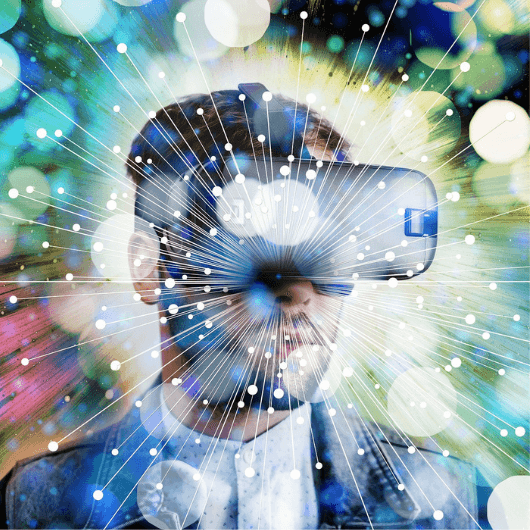Exploring Virtual Reality: Building Innovative Educational Courses in VR
Discover how Virtual Reality is transforming the education sector by creating innovative, interactive, and immersive courses. Get to know the best practices, benefits, challenges, and future trends in VR education.

VIG Learning Team

Introduction
As we embark on the new era of technological advancements in education, disruptive innovations such as Virtual Reality (VR) are revolutionizing the educational landscape. With its distinctive capability to create immersive, interactive, and realistic learning environments, VR offers an extraordinary opportunity for educators and learners. This comprehensive guide explores the ins and outs of designing innovative educational courses using VR, shedding light on its benefits, challenges, best practices, and future trends in this burgeoning field.
Decoding the Influence of Virtual Reality in Education
Virtual Reality, a pioneering technology, creates a simulated environment, submerging users in a three-dimensional world that mirrors reality. When applied in education, VR offers a platform for constructing lifelike scenarios and environments, providing learners with experiential learning opportunities that traditional formats fail to deliver. From performing virtual surgeries in a medical course to traversing the Martian landscape in an astronomy class, the possibilities are truly endless.
Amplifying Learning Experiences with VR
Transforming the conventional, static learning process into an active, engaging experience is one of VR's most significant contributions to education. Its unique characteristics offer a multitude of benefits that traditional education methods struggle to provide. For instance, VR grants learners the ability to engage completely with the subject matter through immersive learning, stimulating multiple senses and leading to enhanced retention and understanding.
Furthermore, VR can simulate intricate scenarios and procedures that may be impossible, dangerous, or costly to replicate in a real-life classroom setting.
VR's Crucial Role in Distance Learning
The COVID-19 pandemic has accelerated the shift towards remote learning, and VR has emerged as a critical component in this new educational paradigm. VR can generate a sense of presence, allowing remote learners to feel as if they're in the same physical space as their peers and teachers.
This capability can help mitigate feelings of isolation and foster a more collaborative and cohesive learning environment.
Weighing the Benefits and
Challenges of VR in
Education
Like any groundbreaking technology, the integration of VR into education brings a unique set of advantages and challenges.
Benefits
1.
- Immersive Learning:*VR offers a degree of immersion that textbooks and lectures cannot match. It enables learners to explore, interact with, and manipulate their learning environment, enhancing their understanding of complex concepts.
2.
- Enhanced Engagement:*The interactive and immersive nature of VR can significantly boost student engagement, leading to increased motivation, improved learning outcomes, and a deeper understanding of the subject matter.
- Safe Learning Environment:VR can simulate potentially hazardous or complex scenarios in a controlled environment, allowing learners to learn from mistakes without facing real-world consequences.
Challenges
- Accessibility:Despite declining costs, high-quality VR equipment can still be a significant investment, potentially limiting its accessibility for some learners.
2.
- Technical Issues:*As with any technology, VR can encounter glitches or technical issues, which can disrupt the learning process.
- Content Development:Creating engaging, high-quality VR content requires specialized skills and resources, which may be a barrier for some educational institutions.
Best Practices for
Building VR Educational Courses
Developing effective VR courses is a complex process that requires meticulous planning and execution. Here are some best practices to consider:
- Define Learning Objectives:Establish clear learning objectives before starting VR content development.
This approach ensures that the VR experiences are aligned with your educational goals.
- Design for Interaction:VR thrives on interaction.
Therefore, design your VR experiences to be as interactive as possible, encouraging learners to explore and engage with their environment.
- Iterate and Refine:VR course development is an iterative process.
Test your VR experiences, gather feedback, and make improvements to refine and enhance the learning experience.
Strategies for Implementing VR in Education
Successfully implementing VR in education requires a strategic approach. Here are some strategies to consider:
1.
- Pilot Programs:*Commence with small-scale pilot programs to evaluate the effectiveness of VR in your specific educational context.
- Educator Training:Provide educators with the necessary training to ensure they're comfortable with VR technology and can facilitate effective VR learning experiences.
- Blend VR with Traditional Learning:VR should be used as a supplement, not a replacement, for traditional learning methods. Integrate VR to enhance your existing curriculum rather than using it as a standalone solution.
Anticipating
Future Trends in VR
Education
As VR technology continues to evolve, several exciting trends are expected to shape the future of VR in education:
- Affordable VR Solutions:Technological advancements are likely to make VR equipment more affordable, increasing its accessibility for learners.
2.
- AI-Driven Personalization:*The convergence of AI and VR will lead to personalized VR learning experiences tailored to individual learners' needs.
- Collaborative VR Learning:Future advances in VR technology will facilitate more collaborative VR experiences, fostering teamwork and cooperation among learners in virtual environments.
Conclusion
The potential of virtual reality to redefine education is immense. It opens up an entirely new world of immersive, interactive learning experiences that can engage and inspire learners like never before. While there are challenges to be addressed, the advantages of integrating VR into education are compelling.
By understanding the principles of VR course design, implementing effective strategies, and staying abreast of future trends, educators can harness the power of VR to transform teaching and learning.
Ready to Transform Your Learning Strategy?
VIG Learning specializes in creating innovative, effective learning solutions that drive real business results. Let's discuss how we can help you achieve your training goals.